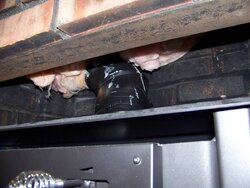About a month ago I had a insert installed. 6" Flex SS liner wrapped w 1/2" insulation. Did the 3 burn in fires and used the excuse of the low target temps as the reason my flue temp wasn't getting as high as recommended. The last fire called for 450 insert top and then I was finally able to get the flue up to 300 but only when the door was cracked up or the draft was full open. I was using a Harbor Freight IR gun to measure it and while I did haven't a reason to not believe it I went ahead and ordered a Condar stovepipe thermometer. Since I am not using a surround I can look/aim above the insert can get temps off the pipe but once that insert gets hot its really tricky reaching around it and figured one day it was going to bite me so best just get a magnetic one. Anyhow went to put it on today and for the life of me it won't stick anywhere on the connector pipe or just above it. The pipe is cold at this point Is it normal or unusual for the pipe to not be made of steel?
So on the 4th firing of it today using pallet wood and a top down fire its going really good about 5 minutes in and the air control on full open and the door is open 1". The temp by IR (since my Condar won't stick) is about 120F as high up as I can aim before its insulated. Its 90F just above the insert itself. Being cautious I felt the pipe and sure enough its warm, but that's it. Seem to me it would be hard to have a hearty fire started in the stove and the flue pipe only be warm to the touch given the comments by others about how fast their flue's heat up. The temp of the stove top (the inner box of the insert's design) is 200+ F at this point. Is the connector double walled and I just don't know it or is there some other reason I can't get the flue very hot? For another data point 2.5 hours into the same burn the inner box temp is 300F and the pipe temp is 150 F
So on the 4th firing of it today using pallet wood and a top down fire its going really good about 5 minutes in and the air control on full open and the door is open 1". The temp by IR (since my Condar won't stick) is about 120F as high up as I can aim before its insulated. Its 90F just above the insert itself. Being cautious I felt the pipe and sure enough its warm, but that's it. Seem to me it would be hard to have a hearty fire started in the stove and the flue pipe only be warm to the touch given the comments by others about how fast their flue's heat up. The temp of the stove top (the inner box of the insert's design) is 200+ F at this point. Is the connector double walled and I just don't know it or is there some other reason I can't get the flue very hot? For another data point 2.5 hours into the same burn the inner box temp is 300F and the pipe temp is 150 F




